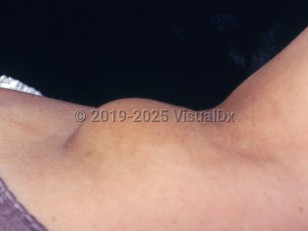Accessory breast tissue
Alerts and Notices
Important News & Links
Synopsis

Breast tissue begins to form in the fourth week of embryologic development along the ventral surface of the body as mammary ridges. The current prevailing theory of accessory breast tissue formation suggests that over time, these ridges regress everywhere except on the breasts, but in some individuals they may persist and contribute to accessory breast tissue (polymastia) and supernumerary nipples (polythelia). Occurrence is approximately 1% of the total population (females more commonly than males), although it may not be recognized until puberty. Rates have been reported as high as 5% in Japanese female individuals and as low as 0.6% in White persons.
Often patients are asymptomatic, and these lesions are noted during a routine exam, but patients may present with swelling or tenderness in the area that may worsen during puberty or pregnancy / postpartum.
Often patients are asymptomatic, and these lesions are noted during a routine exam, but patients may present with swelling or tenderness in the area that may worsen during puberty or pregnancy / postpartum.
Codes
ICD10CM:
Q83.1 – Accessory breast
SNOMEDCT:
18166000 – Accessory breast
Q83.1 – Accessory breast
SNOMEDCT:
18166000 – Accessory breast
Look For
Subscription Required
Diagnostic Pearls
Subscription Required
Differential Diagnosis & Pitfalls

To perform a comparison, select diagnoses from the classic differential
Subscription Required
Best Tests
Subscription Required
Management Pearls
Subscription Required
Therapy
Subscription Required
References
Subscription Required
Last Reviewed:12/19/2021
Last Updated:01/30/2022
Last Updated:01/30/2022
Accessory breast tissue

